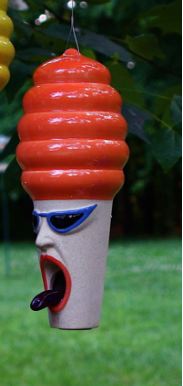-
A New Generation of wild bird feeders
Let’s face it…aesthetics is truly a matter of taste, and sure does vary with each individual. “One man’s trash…”
Bird Feeders are no exception to this rule. A new generation of wild bird feeders range from fun and funky, to antiqued and retro, even the simplistic style of Feng Shui. Most are hand crafted, bringing individual style and uniqueness to each piece. Materials that have been around forever are being used to transform the mundane into terrific art for the garden. Art to be admired, enjoyed, and to feed the birds!
Wild bird feeders for suet, seed, fruit, or just about anything you’d like to offer feathered friends, are crafted by those who have a passion for birds. The quality will surpass any wild bird feeder found in a “big-box store”.
The suet feeder shown here is anything but your traditional wire cage. Sustainable bamboo, glass and stoneware are used to create this beautiful, yet functional wild bird feeder. Weather-proof stoneware is also used in creating the oh-so-fun Hot Lips Hilda. She’s a seed feeder who’s guaranteed to entice many a wild bird.
Whether you’re considering a new feeder for the winter season, or maybe in search of a great gift, consider uniqueness, quality and just plain fun as factors. Wild bird feeders help feathered friends to thrive and flourish all year long.
-
The New Generation of seed catchers
As unsightly as it is, ground waste from bird feeders may also be hazardous to birds’ general health. As seed accumulates on the ground, mold and fungus begin to breed, and bacteria forms which can easily spread among local bird populations. Of course weather will affect this process, depending on heat, humidity and rainfall.
Not only protecting the ground below from waste, and sprouting weeds, the newer seed catchers serve a multi-purpose function. Large, platform type areas catch fallen seed that is appealing to other birds who may not use the actual feeder. There is an additional feeding space at play here, allowing you to entice and attract more feathered friends.
This large recycled plastic seed tray, or seed catcher, is fashioned for larger bird feeders that are mounted on 4×4 posts. Its innovative design really fills a need for these types of feeders. Recycled plastic means it will never crack, split, or warp, so it’s virtually indestructible. Screens lift out for easy cleaning too.
The new Seed Hoops are another brilliant idea in seed catchers. They’re adjustable to fit any hanging bird feeder, including tube feeders. Available in a 16 and a super 30-inch diameter, they’ll eliminate ground waste from any feeder, while creating additional feeding space for new visitors.
- Bird Accessories, Bird Feeders, Bluebird Feeders, Fruit, Jelly & Mealworm Feeders, Mealworm Feeder, Recycled Bird Feeders, Uncategorized, Window Bird Feeder
Add a Mealworm Feeder to Entice Bluebirds
Bluebi
rds covet mealworms, in fact, I’ve discovered that lots of birds love these tasty morsels. In trying to attract bluebirds to this North Georgia yard, first came the bluebird house…but no luck. Then came a bluebird feeder, you know, the kind with the entrance holes that supposedly only bluebirds will fly into for food. Unfortunately that didn’t seem to work either, every different “bluebird delight” on the market was used.
After some quick research, it seemed live mealworms would do the trick, so I squeamishly ordered the first batch. They weren’t too bad, as long as I didn’t have to touch them! Unpacking and storing that first batch was pretty funny looking back at it now. Newspaper spread on the counter, latex gloves, and a semi-faint heart about the whole thing. Then just knowing I had a container of live worms in the fridge…omg! But I wanted to see bluebirds – so I persevered.
Not only did it work, it worked great…Eastern Bluebirds in my yard finally. Two or three showed up at first, and then they began to build a nest in the house. Watching the daily activity was fantastic. A few weeks later the babies started to fledge, one, two, three, four of th
em, all following mom and dad. Truly a great season! It didn’t take long for them to figure out how to enter the mealworm feeder and retrieve their own worms at will. The coolest thing is there was a second successful brood that season too. Watching the juveniles with the new fledgelings was absolutely awesome. Now I’m addicted to meal worms just as much as my bluebirds are. Making sure to feed them twice every day, close to the same time. My new friends stuck around all winter, likely due to the three heated birdbaths, and the regular feeding schedule.
Traditional bluebird feeders aren’t the only way to offer mealworms to feathered friends. Many dish-type styles have attachments for poles, making it simple to add a mealworm feeder to any existing feeding station. Tray type or platform feeders also have the capacity for worms, but there’s no guarantee the bluebirds will get them first. Maybe that’s where the saying “early bird catches the worm” comes from?
This recycled plastic mealworm feeder easily mounts to any standard one-inch diameter pole. The wooden Siamese Cat has a metal screen tray that’s perfect for offering worms too. The best part about these types of feeders is versatility. Foods like suet, peanuts and fruit may also be offered, depending on the species you’d like to attract and season.







